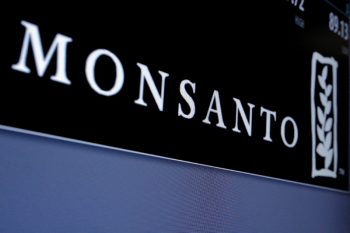Contributing writer for Wake Up World
Monsanto Banned From European Parliament
Late last month, members in the European Parliament (MEPs) announced that Monsanto officials would no longer be able to meet MEPs, attend committee meetings or even use “digital resources” in Brussels or Strasbourg parliament premises, essentially banning them from parliament.[1] The blow came after the biotech giant refused to attend a hearing organized by environment and agriculture committees over allegations that Monsanto engaged in regulatory interference by influencing studies into the safety of glyphosate, the active ingredient in their Roundup herbicide.
The Guardian quoted Green Party president Philippe Lamberts, who stated, “Those who ignore the rules of democracy also lose their rights as a lobbyist in the European parliament … U.S. corporations must also accept the democratic control function of the parliament. Monsanto cannot escape this.”[2] This is one of the strongest examples yet in terms of a large government body not allowing Monsanto lobbyists to talk to its members going forward.
In the U.S., Monsanto has significant influence on government agencies, but even in the U.K., which was originally more resistant to Monsanto’s genetically modified organisms (GMOs), the company has made a lot of headway in changing their image. That being said, European Commission leaders met in March 2016 to vote on whether to renew a 15-year license for glyphosate, which was set to expire in June that year. The decision was tabled amid mounting opposition, as more than 180,000 Europeans signed a petition calling for glyphosate to be banned outright. Ultimately, more than 2 million signatures were collected against relicensing the chemical. In June 2016, however, the European Commission granted an 18-month extension to glyphosate while they continued the review.
A ruling is expected by the end of 2017, which means the lobby ban could not have come at a more inopportune time for Monsanto.
Monsanto Refuses to Attend EU Hearing, MEPs Withdraw Parliamentary Access
NGO Corporate Europe Observatory spokesman Martin Pigeon told The Guardian it was “extremely important that parliament has been prepared to meet Monsanto’s unbelievable arrogance with real retaliation and consequences.”[3] Indeed, in a stark departure from the U.S. government’s cozy ties with Monsanto, the European Parliament has taken a much-needed stand. As for why Monsanto refused to attend the hearing, they said in a letter to MEPs, seen by The Guardian:[4]
“The joint hearing could be viewed as the latest attempt by those opposed to modern agricultural practices to influence and frustrate the EU scientific and regulatory process to suit their own agenda … We have observed with increasing alarm the politicization of the EU procedure on the renewal of glyphosate, a procedure which should be scientific but which in many respects has been hijacked by populism.”
The European Parliament, however, wanted answers regarding reports they were misled about studies on Roundup’s toxicity.
One study in question was conducted by Gilles-Eric Séralini. The lifetime feeding study, published in 2012, revealed numerous shocking problems in rats fed GMO corn, including massive tumors and early death. Rats given glyphosate in their drinking water also developed tumors. The following year, the publisher retracted the study saying it “did not meet scientific standards,” even though a long and careful investigation found no errors or misrepresentation of data.
Interestingly enough, in the time between the publication of the study and its retraction, the journal had created a new position — associate editor for biotechnology, a position that was filled by a former Monsanto employee. The editor of the journal that retracted the study was also reportedly paid by Monsanto.
As GM Watch reported, “ … [E]mails released show that Monsanto was active in the retraction process, though it tried to hide its involvement.”[5] Séralini not only republished the study in another journal, he also took legal action, and at the end of 2015, he won two court cases against some of those who tried to destroy his career and reputation.
In the first case, Marianne magazine and a journalist by the name of Jean-Claude Jaillette — who accused Séralini of “scientific fraud in which the methodology served to reinforce pre-determined results” — were found guilty of public defamation. In a second case, Marc Fellous, former chairman of the Biomolecular Engineering Commission of France, was indicted for forgery and the use of forgery in a libel trial.
Glyphosate Front Group Tells EU Not to Consider Critical Roundup Study
Follow-up research by Séralini showed that long-term exposure to even ultra-low amounts of Roundup may cause tumors, along with liver and kidney damage in rats. In this study, the dose used was “environmentally relevant in terms of human, domesticated animals and wildlife levels of exposure,” prompting the authors to suggest Roundup may have significant health implications.[6],[7]
However, because the original study was “retracted,” it was excluded from the EU glyphosate assessment. The Glyphosate Task Force, an industry front group, even said it was “not considered reliable anymore.”
Hans Muilerman of consumer group Pesticide Action Network (PAN) recently sent letters to EU Health and Food Safety Commissioner Vytenis Andriukaitis and the European Food Safety Authority (EFSA), stating that the study’s exclusion amounts to “a very serious case of manipulation” of science.[8] GM Watch further reported:
“Muilerman writes in his letters, ‘We conclude from these facts that the Glyphosate Task Force’s characterization of the Séralini study as ‘not reliable’ is itself not reliable, originating, as it does, from a campaign orchestrated by Monsanto” … He explains: ‘The Séralini study is the longest chronic experiment with the full formulation of glyphosate — and we know that the co-formulants change its toxicity.
“Since data requirements for chronic toxicity of formulations are missing in the Regulation, the Séralini study fills an important knowledge gap as well as serving the obligation in the Regulation … to take into account cumulative and synergistic effects.
“It is a bitter shame that the Rapporteur Germany accepted this manipulation by the Glyphosate Task Force.’ Muilerman calls on Andriukaitis to ‘commission a fully independent panel of top level scientists that have no link whatever to industry to redo the review.’”
US Scientists Decide to Skip Monsanto’s Dicamba Summit
Roundup isn’t Monsanto’s only controversial and toxic herbicide. Equally contentious is dicamba, which is prone to drifting. The U.S. Environmental Protection Agency (EPA) approved Monsanto’s new weedkiller, XtendiMax, which goes along with its Roundup Ready Xtend cotton and soybeans — GE plants designed to tolerate both glyphosate and dicamba, in November 2016.
However, Monsanto sold dicamba-tolerant cotton and soybean seeds to farmers before the herbicide designed to go with them (which is supposedly less prone to drifting) had gotten federal approval. In 2016, when farmers sprayed their new GE crops with older, illegal formulas of dicamba, and it drifted over onto their neighbors’ non-dicamba-resistant crops, devastating crop damage was reported in 10 states.[9]
Meanwhile, Monsanto held a “dicamba summit” in September 2017 near its headquarters in St. Louis, Missouri, hoping to gain approval from more scientists about its damaging weed killer, but of the approximately 60 people invited, only about 30 reportedly planned to attend. University of Missouri plant sciences professor Kevin Bradley, who’s been tracking crop damage due to dicamba sprayings across the U.S., was among those who declined to attend, citing the company’s unwillingness to discuss volatilization.[10]
Arkansas, Illinois, Missouri, Ohio and Tennessee are presently investigating more than 2,000 reports of dicamba damage.[11] As of August 2017, an estimated 3.1 million acres across the eastern half of the United States have been damaged by dicamba drift.[12] Meanwhile, by June 2017, Arkansas had received more than 400 complaints from farmers whose crops were damaged by dicamba drifting over from neighboring farms.[13]
In response, the Arkansas Plant Board voted to pass an emergency temporary ban on spraying the weedkiller, and by September 2017 state officials were “just one step away” from banning dicamba sprayings in the summer of 2018.[14]
Widespread Monsanto Manipulation Coming to the Surface
Monsanto continues to contest the International Agency for Research on Cancer’s (IARC) 2015 determination that glyphosate is a “probable carcinogen,” even as it’s become clear that they may have worked with a U.S. EPA official to stop glyphosate investigations.
Email correspondence showed Jess Rowland, who at the time was the EPA’s deputy division director of the Office of Chemical Safety and Pollution Prevention and chair of the Cancer Assessment Review Committee (CARC), helped stop a glyphosate investigation by the Agency for Toxic Substances and Disease Registry (ATSDR), which is part of the U.S. Department of Health and Human Services, on Monsanto’s behalf.
In an email, Monsanto regulatory affairs manager Dan Jenkins recounts a conversation he’d had with Rowland, in which Rowland said, “If I can kill this I should get a medal,”[15] referring to the ATSDR investigation, which did not end up occurring.
Meanwhile, former Reuters reporter Carey Gillam has written a revealing book on Monsanto’s long-term and continuing corruption of science, titled “Whitewash: The Story of a Weed Killer, Cancer and the Corruption of Science.” She details the approximately 3,000 plaintiffs in the U.S. who believe exposure to glyphosate caused their, or a loved one’s, cancer, while Monsanto knew it was toxic and covered up the evidence. Court-ordered unsealed documents have revealed that Monsanto scientists ghost-wrote studies to clear glyphosate’s name and even hired a scientist to persuade the EPA to change its cancer classification decision on the chemical.[16]
Gillam also told Corporate Crime Reporter that Monsanto would bully journalists who dared to go against the “corporate narrative.” “Monsanto has made a concerted effort to train reporters on how to report on the industry,” she said. “They are holding boot camps and bringing in these supposedly independent professors and others to train these reporters and others how to think about the science and the issues. They are trying to influence press coverage.”[17]
In addition, she describes the company’s ongoing manipulation of science and the press, and the revolving door that keeps Monsanto in control of government regulations. With the manipulation that continues to come to the surface, the EU Parliament was wise in their decision to withdraw Monsanto’s access. Gillam told Corporate Crime Reporter:
“[Do]cuments show that Monsanto has put together an army of surrogates and soldiers — professors, academics — people who appear to be independent of Monsanto, but who in fact, behind the curtains, are having money funneled to their organizations, to their universities, to their research programs.
“In exchange, some of them are having Monsanto write the presentations that they deliver. They are taking drafts that Monsanto will put together and their name will be put on an independent positive review of glyphosate.
“In fact, Monsanto wrote it. That is not disclosed anywhere … There is also the revolving door. When officials leave the EPA, they can get lucrative jobs within the chemical industry — if they are friendly, if they are useful. There was an EPA official overseeing the glyphosate cancer review. He left the EPA and almost immediately started getting work with the chemical industry. And Monsanto loved this guy.
“They talked about it in their internal documents, how useful he could be. And how they wanted him to be the one they were dealing with, instead of somebody else on the glyphosate issue.”
You Can Find Out How Much Glyphosate is in Your Body
Laboratory testing commissioned by the organizations Moms Across America and Sustainable Pulse revealed that glyphosate is now showing up virtually everywhere. The analysis revealed glyphosate in levels of 76 ?g/L to 166 ?g/L in women’s breast milk. As reported by The Detox Project, this is 760 to 1,600 times higher than the EU-permitted level in drinking water (although it’s lower than the U.S. maximum contaminant level for glyphosate, which is 700 ?g/L.).[18]
This dose of glyphosate in breast-fed babies’ every meal is only the beginning. An in vitro study designed to simulate human exposures also found that glyphosate crosses the placental barrier. In the study, 15 percent of the administered glyphosate reached the fetal compartment.[19] Glyphosate has also been detected in a number of popular foods, including oatmeal, coffee creamer, eggs and cereal, such as Cheerios.
If you’d like to know your personal glyphosate levels, you can now find out, while also participating in a worldwide study on environmental glyphosate exposures. The Health Research Institute (HRI) in Iowa developed the glyphosate urine test kit, which will allow you to determine your own exposure to this toxic herbicide.
Ordering this kit automatically allows you to participate in the study and help HRI better understand the extent of glyphosate exposure and contamination. In a few weeks, you will receive your results, along with information on how your results compare with others and what to do to help reduce your exposure. We are providing these kits to you at no profit in order for you to participate in this environmental study.
In the meantime, eating organic as much as possible and investing in a good water filtration system for your home are among the best ways to lower your exposure to glyphosate and other pesticides. In the case of glyphosate, it’s also wise to avoid desiccated crops like wheat and oats.
Biotech Companies are Gaining Power by Taking Over the Government
There is no doubt in my mind that GMOs and the toxic chemicals used along with them pose a serious threat to the environment and our health, yet government agencies turn a blind eye and refuse to act — and the reason is very clear: They are furthering the interests of the biotech giants.
It is well known that there is a revolving door between government agencies and biotech companies such as Monsanto. Consider the hypocrisy of the FDA. On paper, the U.S. may have the strictest food safety laws in the world governing new food additives, but this agency has repeatedly allowed GMOs and their accompanying pesticides such as Roundup to evade these laws.
In fact, the only legal basis for allowing GE foods to be marketed in the U.S. is the FDA’s claim that these foods are inherently safe, a claim which is patently ridiculous. Documents released as a result of a lawsuit against the FDA reveal that the agency’s own scientists warned their superiors about the detrimental risks of GE foods. But their warnings fell on deaf ears.
The influence of the biotech giants is not limited to the U.S. In a June 2017 article, GMWatch revealed that 26 of the 34 members of the National Advisory Committee on Agricultural Biotechnology of Argentina (CONABIA) are either employed by chemical technology companies or have major conflicts of interest.
You may be aware that Argentina is one of the countries where single-crop fields of GE cotton, corn and soy dominate the countryside. Argentina is also a country facing severe environmental destruction. Argentinians are plagued with health issues, including degenerative diseases and physical deformities. It would appear that the rapid expansion of GE crops and the subsequent decline in national health indicators are intrinsically linked.
Don’t Be Duped by Industry Shills!
Biotech companies’ outrageous attempts to push for their corporate interests extend far beyond the halls of government. In a further effort to hoodwink the public, Monsanto and its cohorts are now zealously spoon-feeding scientists, academics and journalists with questionable studies that depict them in a positive light.
By hiring “third-party experts,” biotech companies are able to take information of dubious validity and present it as independent and authoritative. It’s a shameful practice that is far more common than anyone would like to think. One notorious example of this is Henry Miller, who was thoroughly outed as a Monsanto shill during the 2012 Proposition 37 GMO labeling campaign in California.
Miller, falsely posing as a Stanford professor, promoted GE foods during this campaign. In 2015, he published a paper in Forbes Magazine attacking the findings of the International Agency for Research on Cancer, a branch of the World Health Organization, after it classified glyphosate as a probable human carcinogen. After it was revealed that Miller’s work was in fact ghostwritten by Monsanto, Forbes not only fired him, but also removed all of his work from its site.
Industry front groups also abound. The Genetic Literacy Project and the American Council for Science and Health are both Monsanto-funded. Even WebMD, a website that is often presented as a trustworthy source of “independent and objective” health information, is acting as a lackey for Monsanto by using its influence to promote corporate-backed health strategies and products, displaying advertisements and advertorials on Biotech’s behalf, furthering the biotech industry’s agenda — all for the sake of profit.
Monsanto has adopted underhanded tactics to peddle its toxic products, but the company is unable to hide the truth: Genetic engineering will, in no way, shape or form, make the world a better place. It will not solve world hunger. It will not increase farmers’ livelihoods. And it will most certainly not do any good for your health — and may in fact prove to be detrimental.
There’s No Better Time to Act Than NOW — Here’s What You Can Do
So now the question is: Will you continue supporting the corrupt, toxic and unsustainable food system that Monsanto and its industry shills and profit-hungry lackeys have painstakingly crafted? It is largely up to all of us, as consumers, to loosen and break Monsanto’s tight hold on our food supply. The good news is that the tide has been turned.
As consumers worldwide become increasingly aware of the problems linked to GE crops and the toxic chemicals and pesticides used on them, more and more people are proactively refusing to eat these foods. There’s also strong growth in the global organic and grass fed sectors. This just proves one thing: We can make a difference if we steadily work toward the same goal.
One of the best things you can do is to buy your foods from a local farmer who runs a small business and uses diverse methods that promote regenerative agriculture. You can also join a community supported agriculture (CSA) program, where you can buy a “share” of the vegetables produced by the farm, so that you get a regular supply of fresh food. I believe that joining a CSA is a powerful investment not only in your own health, but in that of your local community and economy as well.
In addition, you should also adopt preventive strategies that can help reduce the toxic chemical pollution that assaults your body. I recommend visiting these trustworthy sites for non-GMO food resources in your country:
- Organic Food Directory (Australia)
- Organic Explorer (New Zealand)
- Eat Wild (Canada)
- Eat Well Guide (United States and Canada)
- Farm Match (United States)
- Local Harvest (United States)
- Weston A. Price Foundation (United States)
Monsanto and its allies want you to think they control everything, but they do not. It’s you, the masses, who hold the power in your hands. Let’s all work together to topple the biotech industry’s house of cards. Remember — it all starts with shopping smart and making the best food purchases for you and your family.
Recommended articles by Dr. Joseph Mercola:
- Anxiety Overtakes Depression as No. 1 Mental Health Problem
- How LED Lighting May Compromise Your Health
- Magic Mushrooms May Hold Key to Long-Term Relief from Anxiety and Depression
- Medical Errors: Still the Third Leading Cause of Death
- Photobiology: How Therapeutic Use of Full-Spectrum Light Can Improve Your Health
- Scientific Links Between Processed Foods and Depression
- How Sugar Harms Your Brain Health and Drives Alzheimer’s Epidemic
- The Health Benefits of Intermittent Fasting
- Can a Hug a Day Keep Infection Away?
- The Magic Healing Power of Mushrooms
- 13 Mind-Body Techniques That Can Help Ease Pain and Depression
About the author:
 Born and raised in the inner city of Chicago, IL, Dr. Joseph Mercola is an osteopathic physician trained in both traditional and natural medicine. Board-certified in family medicine, Dr. Mercola served as the chairman of the family medicine department at St. Alexius Medical Center for five years, and in 2012 was granted fellowship status by the American College of Nutrition (ACN).
Born and raised in the inner city of Chicago, IL, Dr. Joseph Mercola is an osteopathic physician trained in both traditional and natural medicine. Board-certified in family medicine, Dr. Mercola served as the chairman of the family medicine department at St. Alexius Medical Center for five years, and in 2012 was granted fellowship status by the American College of Nutrition (ACN).
While in practice in the late 80s, Dr. Mercola realized the drugs he was prescribing to chronically ill patients were not working. By the early 90s, he began exploring the world of natural medicine, and soon changed the way he practiced medicine.
In 1997 Dr. Mercola founded Mercola.com, which is now routinely among the top 10 health sites on the internet. His passion is to transform the traditional medical paradigm in the United States. “The existing medical establishment is responsible for killing and permanently injuring millions of Americans… You want practical health solutions without the hype, and that’s what I offer.”
Visit Mercola.com for more information, or read Dr. Mercola’s full bio and resumé here.

If you've ever found value in our articles, we'd greatly appreciate your support by purchasing Mindful Meditation Techniques for Kids - A Practical Guide for Adults to Empower Kids with the Gift of Inner Peace and Resilience for Life.
In the spirit of mindfulness, we encourage you to choose the paperback version. Delve into its pages away from screen glare and notifications, allowing yourself to fully immerse in the transformative practices within. The physical book enriches the learning process and serves as a tangible commitment to mindfulness, easily shared among family and friends.
Over the past few years, Wake Up World has faced significant online censorship, impacting our financial ability to stay online. Instead of soliciting donations, we're exploring win-win solutions with our readers to remain financially viable. Moving into book publishing, we hope to secure ongoing funds to continue our mission. With over 8,500 articles published in the past 13 years, we are committed to keeping our content free and accessible to everyone, without resorting to a paywall.








